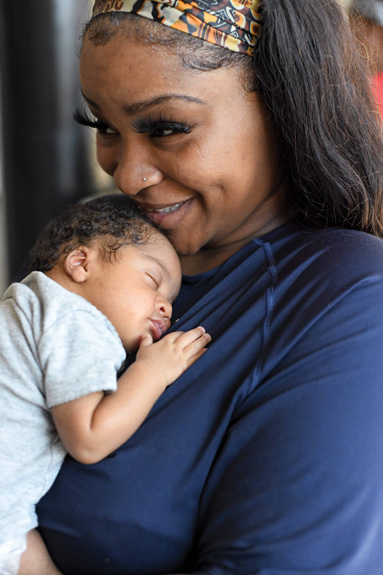Konprann Somèy
Mete tibebe w la dòmi sou yon sifas ki fèm, san okenn objè, epi sou do li. Tibebe ki fenk fèt yo antre nan somèy lejè okòmansman, apresa yo antre nan somèy pwofon nan apeprè 20 minit.
- Li reveye fasil
- Li mouvmante epi li fè bwi
- Je l bouje anpil
- Li fè rèv
- Sèvo a ap grandi ak devlope!
- Li pa reveye fasil
- Li gen bra ak janm ki rilaks epi mòl
- Li pa bouje twòp
- Sèvo a ap repoze!
- Tann siy somèy pwofon yo anvan ou mete tibebe w la kouche. Pa bliye, tibebe ki fenk fèt yo pran apeprè 20 minit pou yo antre nan somèy pwofon.

Konprann Siyal yo
Tibebe w la kapab di w sa li bezwen san mo lè l sèvi avèk siyal kò li. Lè w reponn a siyal li yo sa ka ede tibebe w la rete kalm epi kontan.

- Siyal “Mwen Grangou” yo
- Li kite men l toupre bouch li
- Li pliye bra l ak janm li
- Li fè bri souse
- Li peze po bouch li ansanm
- Li chèche pwent tete a
Kounye a se bon lè pou ba yo manje, anvan yo vin
twò grangou.
- Siyal “Mwen bezwen yon bagay chanje”
- Li gade yon lòt kote oswa li vire tèt yo oswa bosi do yo
- Fwonse sousi yo oswa gen yon rega ki lwen
- Li fè men l, bra l, oswa janm li rèd
- Li ka baye oswa dòmi ka pran l
Sa vle di yo pa alèz oswa gen yon bagay ki deranje yo. Kite yo vire oswa repoze. Bri, limyè, oswa twòp moun ka fatigan pou ti bebe.
- Siyal “Mwen Vant Mwen Plen”
- Li souse pi lan oswa li sispann souse
- Li lache men l ak bra l
- Li vire do bay pwent tete a
- Li pouse kò l
- Dòmi pran l
Siyal sa yo vle di yo pare pou yo sispann manje.
- Siyal “Mwen Vle Toupre Ou”
- Vizaj ak kò dekontrakte
- Li suiv vwa ou ak figi w
- Li lonje men ba ou
- Li gade w nan je
- Li leve tèt li
Sa vle di yo pare pou kominike, aprann, oswa
jwe avèk ou!

Konprann Kriye
Sa ka boulvèsan anpil pou paran yo lè tibebe yo kriye. Tout ti bebe kriye pafwa. Tibebe yo kriye pou plizyè rezon, pa sèlman paske yo grangou oswa yo bezwen yon chanjman kouchèt. Genyen bagay ou kapab fè pou ede tibebe w la santi l pi byen.
- Rete kalm epi pran pasyans.
- Sèvi ak siyal tibebe w la pou eseye chèche konnen sa li ap di w.
- Kenbe tibebe w la toupre w epi eseye:
- Fè kontak po ak po.
- Pale dousman oswa chante plizyè fwa.
- Souke oswa balanse tibebe w la dousman plizyè fwa.
- Mase do, bra, ak janm li dousman.
- Si w kòmanse santi w fache oswa akable, mete tibebe w la yon kote ki an sekirite epi pran yon ti repo.
- Kontakte doktè w si w panse tibebe w la ap kriye twòp.
Pou aprann plis bagay sou zafè kriye, ale sou www.purplecrying.com.
Konsèy Rapid pou Paran yo
- Bay tibebe w la manje lè l fè w konnen li grangou, pa gade sou revèy la.
- Etenn limyè ak televizyon kote tibebe w la ap dòmi an.
- Repoze pandan tibebe w la ap dòmi (menm chita trankilman ka ede w santi w plis repoze).
- Si w kòmanse santi w fache oswa akable, mete tibebe w la yon kote ki an sekirite epi pran yon ti repo.
- Mande zanmi ak fanmi w èd avèk travay nan kay la.
Pou w jwenn yon klinik WIC ki toupre w, rele nan 800-522-0874 oswa ale sou sitwèb nou an ki se wic.in.gov. Jwenn plis enfòmasyon sou somèy san danje pou tibebe yo nan lyen sa a.
Enstitisyon sa a ofri tout moun menm opòtinite.